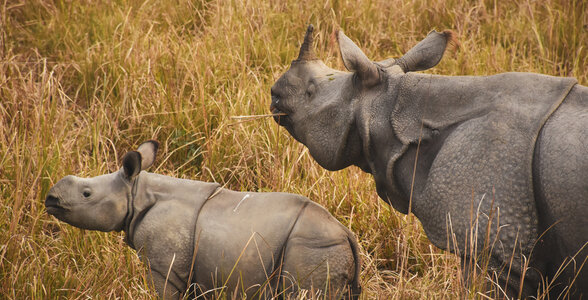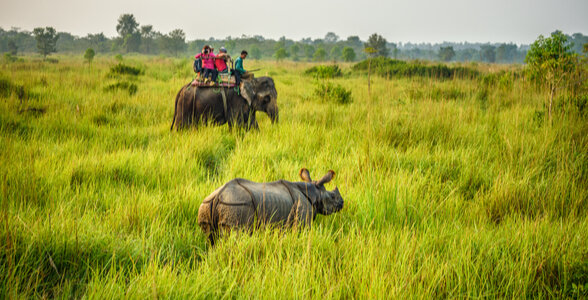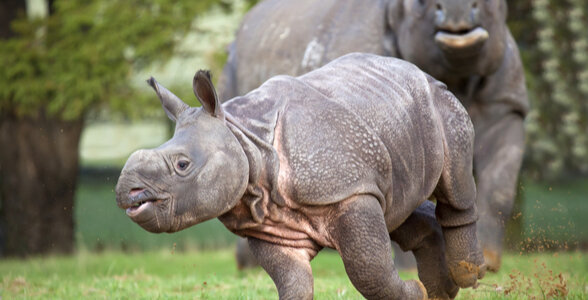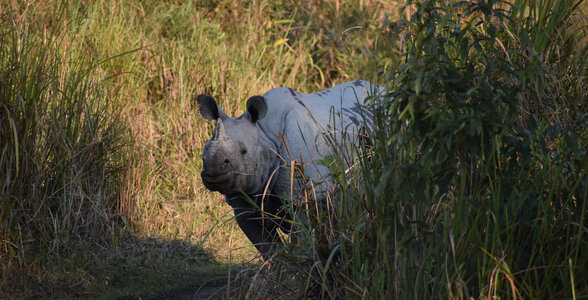September 23, 2021
World Rhino Day 2021 - All About the Rare One-Horned Rhinos
CM Content Team
Under the bright sun, like Vikings opposite each other, horn to horn seemed to get into a battle, but the two just glanced at each other and quietly lumbered. This is the beauty of the rare one-horned rhinos found in India. Co-existing with several other creatures belonging to the animal kingdom, they have less to do, but with, their own- selves. Let’s gather a bit more information about this world-renowned species that falls in the Vulnerable category on the IUCN Red List
The scientific name of One-horned rhino is Rhinoceros unicornis, which is derived from the Greek “rhino”, meaning “nose” and “ceros”, meaning “horn” and “unicornis” from the Latin “uni”, meaning “one” and “cornis”, meaning “horn”. The largest and the rarest existing mammal, the greater one-horned rhino was earlier found in northern Pakistan, northern parts of India, Nepal, Myanmar, and Northern Bangladesh.
Hunting practices and the depletion of the habitat which included the riverine forest and alluvial Terai-Duar savanna and grasslands, almost brought the species to extinction in the 20th century.
Thanks to Mary Curzon, the wife of Lord Curzon, the Viceroy of India, while visiting Kaziranga National Park back in 1904, on not sighting a single rhino, coaxed Lord Curzon to begin conservation in the area. After which in 1905, the Kaziranga Reserve Forest was established, which by 1974 evolved into the Kaziranga National Park.
Kaziranga, called the Land of Giants, characterizes rich natural habitat featuring bountiful open expanses, often compared with Africa. The National Park today homes two-thirds of the world’s greater one-horned rhinos. A decent number of them are also found in Royal Chitwan National Park established in 1973.
Decades of conservation took Rhinoceros unicornis to shift from endangered category to the list of vulnerable species. In the year 1975, there were only 600 rhinos that managed to survive in India and Nepal. Fortunately, with the strict protection, rules and regulations laid down by the wildlife authorities across India and Nepal, the numbers recorded have increased to around 3,700 in Nepal and India. This rare species has been brought back from the brink of extinction by rigorously tackling facets of wildlife crime like poaching, trafficking, and buying.
LOCATION: found in India and Nepal, predominantly in the foothills of the Himalayas. In early times they roamed free in the forests and floodplains alongside the Ganges, Brahmaputra, and Indus River valley.
HABITAT: are semi-aquatic and usually dwell in riversides, swamps, and forests.
TYPE: Mammals
DIET: are Herbivores and feed on branches, shrubs, leaves, fruits grasses, and aquatic plants.
AVERAGE LIFE SPAN: 40 years
SIZE: Length: 12.5 feet; height at shoulder: up to 6 feet
WEIGHT: 2.2 tons
SKIN: possess ashy grey, hairless skin that develops thick folds, that resembles armour plating. The skin helps in thermo-regulation, which means that the animal can regulate its body temperature in varying weather conditions.
THE HORN: a greater one-horned rhino has a single horn 8 to 24 inches (20 to 61 cm) long which weighs up to 3 kg. The structure of the horn is similar to the hooves of a horse, and can re-grow if broken. The rhinos use the horn to search for roots and other types of food.
TERRITORIES: males usually stay solitary except the females who tuck along with their young ones. The females have overlapping territories that depend upon the availability of food and other resources. Males have loosely-defended territories, and they fight violently for favored routine areas.
SEXUAL MATURITY: females at the age of 4 begin to breed while males become sexually mature at 9 years of age.
GESTATION: between 15-16 months.
BIRTH: at birth, a younger one can weigh up to 58-70kg.
Kaziranga National Park, Assam; Pobitora Wildlife Sanctuary, East of Guwhati; Jaldapara National Park, West Bengal; Orang National Park, Assam; Gorumara National Park, West Bengal; Manas National Park, Assam; Dudhwa National Park, Uttar Pradesh; Dibru Saikhowa National Park Near Dibrugarh, Assam.
RHINOS ARE CALLED BULLS & COWS – Male rhinos are called bulls, females are called cows, and the young ones are called calves. Rhinos together in a group are called a crash.
RHINOS HAVE POOR VISION – Rhinos are short-sighted as they are unable to see static objects at a distance of 30 m. They have a strong sense of smell and can hear well.
RHINOS COMMUNICATE THROUGH SNORTS, SNEEZES & HONKS
Rhinos are good at making funny sounds and are adept at creating 12 different types of sounds. They make trumpet calls and growl during confrontations. They snort in anger and make alarm calls through sneezing. They scream when they are scared, and mmwonk when relaxed.
RHINOS LEAVE THEIR MARK THROUGH THEIR URINE & POOP
Rhinos have scent glad at the bottom of their feet. Their whereabouts can be traced by their urine and dunk which tends to get stuck on their feet and gets distributed wherever they go.
RHINOS ARE GREAT SWIMMERS
Rhinos love to swim and can dive and feed underwater. They enjoy cool and wet places like lakes and riverine surroundings.
RHINOS CAN RUN
Rhinos can run as fast as (up to 40 km/h) and are very alert, despite their massive shape and size.
RHINOS ENJOY MUDDING
Rhinos often are seen wallowing in the mud. Many of them gather in places filled with mud that serve as meeting points for them to gather socially and chill out together.
Mahindra Holidays & Resorts India Limited (MHRIL), India’s leading player in the leisure hospitality industry, offers quality family holidays as also stated by Club Mahindra Resort Reviews and Club Mahindra Reviews, primarily through vacation ownership memberships. While Club Mahindra is the flagship brand offering Club Mahindra Membership, other brands offered by the company are – Club Mahindra Resorts Fundays and Svaastha Spa. As of Mar 31, 2019, MHRIL has 61+ resorts across India and abroad and its subsidiary, Holiday Club Resorts Oy, Finland, a leading vacation ownership company in Europe has 33 resorts across Finland, Sweden and Spain. Visit us at https://www.clubmahindra.com/
Mahindra Holidays & Resorts India Ltd. (MHRIL), a part of Leisure and Hospitality sector of the Mahindra Group, offers quality family holidays primarily through vacation ownership memberships and brings to the industry values such as reliability, trust and customer satisfaction. Started in 1996, the company's flagship brand ‘Club Mahindra’, today has over 290,000 members , who can holiday at 140+ resorts in India and abroad.



